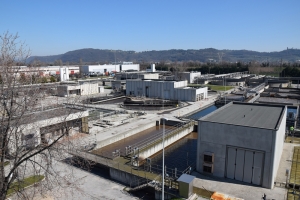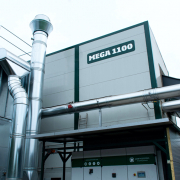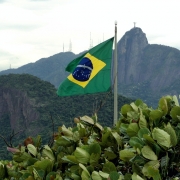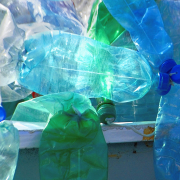India’s Sewage Treatment Policy: Between Dysfunctionality and Multi-Billion Dollar Opportunity
India’s expanding agriculture, industry and modern communities require increasingly large amounts of water. For the country facing a most serious water scarcity, polluted rivers as well as contaminated ground water, the cleaning and recycling of water seems the only solution. But the era of commonly functioning sewage treatment plants has just begun.
According to the environment agency Central Pollution Control Board (CPCB), India produces 62 billion liters of wastewater per day. Figures from 2010 show that water consumption comprised of 2.2 percent of industrial, 7.4 percent of municipal, and 90.4 percent of agricultural usage. The 500 million liters per day (mld) generation of industrial wastewater is composed of 200 mld of the production of pulp and paper, 98 mld of chemical and 96 mld of sugar production. However, concerning industrial wastewater, the Indian supreme court in February 2017 directed the CPCB to control the treatment in all industrial units; in case of violation, they are threatened by closure.
Urban and rural areas differ
The municipal wastewater generation must be distinguished between urban and rural: An official statistical status report for 2012 offers that in rural regions half of the households have no drainage; their wastewater is by 75.9 percent disposed to open low land areas. In urban regions, 45 percent of the dwellings are connected to an underground drainage system. But stormwater in the cities causes another problem: The rainwater cannot be absorbed into the ground and get percolated. Thus, it runs off untreated into sudden drains and transports domestic waste and other water to lakes and rivers. Although partially water in agriculture and in horticulture – treated or untreated – is reused, this sector takes up about eight times as much water as the other two put together. The effluent load of the branch complies with the conditions of urban regions; the environmental contamination by agricultural fertilizers, dung and animal excreta is another chapter.
Treatment capacity underutilized
In 2016, the connection rate of the Indian population to the wastewater and sewage network in 2016 totaled 38.1 percent – differing between the regions. According to Standford’s Social Innovation Review in Spring 2017, India’s smaller towns cannot afford to build dedicated treatment systems. Only the country’s largest cities have centralized sewage systems that are completed with underground pipes, pumping stations, and treatment plants. “However, these systems are expensive to build and to operate, requiring uninterrupted power, skilled operators, and extensive maintenance.” A survey report of the CPCB for 2014/2015 underlines that nearly 39 percent of the plants are not conforming to the general standards prescribed under the Environmental Protection Rules for discharge into streams. And – as the paper assesses – in several cities the existing treatment capacity remains underutilized while a lot of sewage is discharged without treatment in the same city. Even in July 2018, the existing sewerage infrastructure in most cities was characterized “by obsolete and faulty pipeline networks, insufficient treatment capacity and sub-optimal capacity utilization”.
Capacity rose from 209 to 920 plants
During the years, the number of sewage treatment plants has increased. In 1992, a World’s Health Organization study reported that out of India’s 3,119 towns and cities just 209 had partial wastewater treatment facilities, only eight had full facilities, and 114 cities dumped untreated sewage and partially cremated bodies directly into the Ganges River. In 2014/15, the CPCB announced a total of 816 plants presenting a capacity of 23,277 mld. And in November 2016, Shri Anil Madhav Dave, Minister of State for Environment, Forest and Climate Change, disclosed newer CPCB figures: 193 common effluent treatment plants are installed in the country with a combined capacity of 1,474 mld. There are 920 sewage treatment plants (STPs) in different states, including Tamil Nadu and West Bengal, out of which 615 STPs are operational, 80 STPs are non-operational, 154 STPs are under construction, and 71 STPs are under planning stage. The estimated sewage generation in the country was 61,948 mld in 2015 against the available treatment capacity of 23,277 mld. This means in effect that 38,671 mld or 62 percent are not treated. Figures of the Centre for Science and Environment for 2009 indicated the differences throughout the Indian regions: While the treatment capacity of 35 metropolitan cities with a population of more than one million people added up to 51 percent, Class I cities only commanded equipment for 32.5 percent, and Class II cities reached 12 percent. Numbers of Ernst & Young for 2013 differentiate that only 60 percent of industrial and 26 percent of domestic wastewater was treated in India.
Rising demand for treatment
However, the relations of water-consuming and therefore wastewater generating and application of sewage treatment facilities will change. The rising population of India and rapid urbanization are two reasons, dwindling freshwater reserves and a depleting groundwater table two other factors for a rising wastewater treatment demand. Growth is also caused by domestic and industrial water requirements expected to double by 2030, whereas agriculture’s growth rate will only rise 11 percent. The demand is estimated to rise between 2010 and 2030 from 34 to 66 billion cubic meters in the domestic sector, from 40 to 91 billion cubic meters in the industry, and 606 to 674 billion cubic meters in agriculture, Ernst & Young gave account. The German Federal Ministry for Economic Affairs and Energy (BMWi) even expects a demand that will quadruple by 2030. Over the long term, India has to react to the low water quality and contaminants like geogenic dissolved Arsenic and Fluoride as well as man-made discharged pollutants like Chloride, Iron and Nitrates anyway. Besides that, the demand will increase by the necessity of better common collection, treatment and disposal or reuse of fecal sludge: At the India Sanitation Conclave at New Delhi in April 2018, there was a loud call for an “open defecation free” India. A United Nations report in 2015 regarding this item indicated an estimated 65,000 tons of uncovered and untreated feces released to the environment in India every day. Manas Rath, senior advisor of Bremen Overseas Research and Development Association (BORDA), South Asia, expects a business potential of 4.5 billion US-Dollar in the sanitation sector within the next 10 years.
Between dysfunctional and operational
But the current equipment for sewage treatment – even in India’s big cities – was not fit for the tasks. In 2003 the German Federal Agency for Foreign Trade spoke of a majority of 85 percent of plants treating sewage mechanically or biologically, while only 35 percent of them referred to a mechanical and chemical/physical procedure by leaching, infiltration, deposition or flotation. A study published by German RETech Partnership in 2018 illustrates that in these 85 plants drinking water is processed in mechanical treatment facilities by sedimentation, sand filtration and chlorination, which contributes to an improved water quality only to a lesser extent. In 2014, Prakash Javadekar, Union Minister of State for Environment, Forests and Climate Change, stated that 70 percent of India’s sewage treatment plants were “dysfunctional”. And the journal Water Online balanced in 2017: “In fact, of the waste treatment plants that are there, many are not even functioning. Either they are in severe need of repairs and maintenance, or they simply never took off.” In contrast, a report on the sewage treatment market in India notifies that from 2009 to July 2018 the country’s sewage treatment capacity increased from 11,787 mld to 26,066.31 mld in 2018 and that “about 83 percent is currently operational”.
A costly affair
Sewage treatment plants are a costly affair: The average setting up costs of a plant currently ranges from Rupees 7,000,000 to 11,000,000 (88,000 – 137,000 Euro) per million liters a day of sewage generated. Hence, a facility with 300 mld treating capacity is calling for Rupees 300 crore (Rupees three billion / 374 million Euro). If the primary treatment system of the plant is replaced by a primary + ultra-filtration system or even by a primary + ultra-filtration system + reverse osmosis, the capital costs can rise from Rupees three million to 14.5 million and the treatment costs from Rupees 4.4 million to 7.3 million, says a study published by the UN-Water Activity Information System.
Additionally, a medium-sized plant needs energy. According to the homepage of the Banega Swasth India Campaign, to work continuously, the treatment of 200 mld requires one MW of power supply, a quantity not given everywhere. In 2010 the CPCB surveyed 84 sewage treatment plants, of which only eight could access the public power grid steadily and 12 use alternative sources. Additionally, maintenance costs for a medium-sized plant arise amounting from Rupees 7,000,000 to 20,000,000 (88,000 – 250,000 Euro). As a CPCB report of 2015-2016 estimated, nearly half of the plants had an outdated infrastructure based on old machinery, undersized balancing tanks or dated clarifiers. Not to forget the operating crew being understaffed or poorly trained. Against this background, the sewage treatment plant for the processing of 45 million gallons per day in Kondli near Delhi seems to be an exception, to follow Rajiv Mittal, Managing Director of water treatment firm VA Tech Wabag: “Our plant can generate two MW of power from sewage and will not need a single unit from the grid. The only cost that remains is manpower, chemicals, etc.”
Insufficient conditions
A discussion paper from the German Institute for Development Policy summarized the problems: “Regulatory gaps remain concerning taxation for sewerage when new buildings are constructed, the systematic integration of sewerage into water tariffs and the systematic setting of discharge standards, reuse standards and regulations for nutrient recovery from sludge.” Besides that, the paper criticized the delay of investments in energy-efficient and of lifecycle-oriented wastewater systems that would be most suitable for the concrete local conditions. “India lacks sewage systems and wastewater management plants sufficient to meet the needs of its growing urban population.” This was the thematic hook of a “sector analysis”, published by the Trade Council India in August 2015, offering opportunities in the Indian water market – worth around 12 billion US-Dollar with an annual growth rate of 15-20 percent – for the Danish water industry. The analysis paper did not keep secret that the Indian water and water treatment industries are very cost competitive and sometimes limiting the use of expensive (foreign) technologies. That bureaucracy and corruption represent a significant hindrance to the ease of doing business. And that locally fabricated equipment is about 30 percent cheaper than imported equivalents.
A great market potential
But it also illustrated existing opportunities through technical consultancy in the wastewater treatment industry through the contractual and/or joint venture route, a favorable business environment for production companies, the government’s investment in and focus on PPP in ambitious infrastructural projects, great opportunities for companies working with the membrane technology instead of chemical treatment and demineralization technologies as well as better capabilities of foreign firms in designing technologies for larger-scale water treatment plants. “Innovative and futuristic management techniques” were wanted to guarantee “minimum use of water, recycling and reusing wastewater for industrial uses and ensuring a highly efficient water use in irrigation”. A market analysis on India’s water and wastewater economy in 2016, edited by BMWI, condensed: “The Indian government has realized the problem of wastewater disposal and processing, shown by increasing numbers of requirements. Communities all over India are searching for efficient solutions for wastewater treatment.” The paper saw overall “a great market potential”.
Funded worldwide
The official policy supports the improvement in the water and wastewater sector. A National Water Policy exists since 1987 and was twice revised in 2002 and 2012. The 12th Five Year Plan intended the investment of 26.5 billion US-Dollar until 2017 to provide safe water to all Indians. After the election of Narendra Modi as state minister in 2014, India started up some new initiatives and also continued others of previous governments. During three years the construction of more than 100 sewage treatment plants was proposed. The policy was funded amongst others by the World Bank, Asian Development Bank, Japan Bank for International Cooperation (JBIC) and the German Society for International Cooperation (GIZ). Funding went inter alia to the Swachh Bharat Abhiyan or Clean India Mission with approximately nine billion US-Dollar, the Amrut for Rejuvenation and Urban Transformation Mission for the enhancement of sewerage connections and sewerage treatment facilities and the Smart Cities initiative for sanitation and solid waste management plans. Among the dozens of projects of the National Mission for Clean Ganga, two billion US-Dollar were invested in river sanitation and new sewage treatment plants along the river Ganges.
Primarily demanded by the industry
Some years ago, wastewater treatment was primarily demanded by the industry. Firstly, because several branches like the pharmaceutical needed normal to ultra-purified water, secondly because municipal bodies could not obtain customers for the service of treated sewage water if it is not potable. (For comparison: The first Faecal Sludge Treatment Plant converting the toilet waste of a town of 30,000 into compost opened in May 2018.) As industry grows faster than the governmental water supply, the companies primarily backed private service in the area of water delivery and wastewater disposal. According to BMWi, experts expect the expenditures on corresponding technologies to grow annually by five to ten percent. German RETech Partnership estimates a growth rate of five to 15 percent annually in the market for industrial wastewater disposal. Shishir Joshipura, CEO at equipment processing manufacturer Praj Industries Ltd., expects the industrial wastewater sector to see a strong double-digit growth possibly in the range of 10 to 12 percent per annum. So does Christian Ziemer, Manager Business Development and Strategy, Water & Wastewater at Siemens AG. And he not only sees market opportunities in cooperating with large Indian businesses but also for small and medium-sized companies increasingly investing in innovative water and wastewater solutions. The homepage of Everything about Water presented estimations on India’s total water and wastewater treatment market being worth about 420 million US-Dollar and growing by an annual rate of about 18 percent. Merely the 12. Five Year Plan (2012-2017) considered an economic growth of eight to nine percent possible under the condition that water-related requirements of the growing population are met. Anyhow, the demand is present: End of July 2019, Suez signed a contract providing for a 3.5-year design and construction phase of the plant in New Delhi, followed by an 11-year operation and maintenance phase. Suez thus won a 145 million Euro contract to build and operate India’s largest wastewater treatment plant.
A multi-billion Dollar opportunity
Prospectively, there will be increased demand for higher-value technologies also in the municipal area that meets the legal requirements which have become stricter. Franz Heindl, Director International Sales at Huber SE, is convinced: “This sector’s market potential currently is higher than the one of municipal sewage treatment, as the statutory provisions put enormous pressure on companies that in turn need to react fast. In the medium to long term, however, the municipal need will by far exceed the industrial one.” This is proven by another contract subscribed by Degrémont, subsidiary of SUEZ Environment. Nearly contemporaneous with the Suez handshake, authorities in the Indian city of Chennai and Degrémont on the 19th of July 2019 opened the country’s second-largest drinking water production plant. With total costs of 25.2 million Euro, this plant will provide 530,000 m3/day of potable water to almost four million people.
Not for nothing research store Research and Markets called his newest edition the “Multi-billion Dollar Opportunity for Project & Services in Water and Wastewater Treatment Industry in India: What is the Next Oil?”-report.
(GR12020, Page 28, Photo: Bergringfoto / stock.adobe.com)










